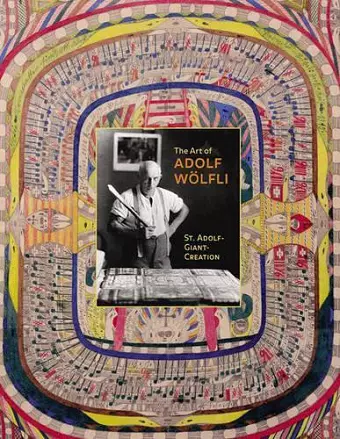The Art of Adolf Wölfli
St. Adolf-Giant-Creation
Daniel Baumann author Edward M Gomez author Elka Spoerri author
Format:Hardback
Publisher:Princeton University Press
Published:14th Mar '03
Currently unavailable, our supplier has not provided us a restock date

The three essays in this volume make a real contribution to the field. The piece by Elka Spoerri, who was the grande dame of Wolfli studies, is wonderfully accessible and reflects groundbreaking scholarship. It will reach a wide audience and will make a great text for any art history class. Bauman's well-written essay stands as the definitive contextualization of Wolfli's place within twentieth-century art history. Gomez's innovative and compelling exploration of whether Wolfli as a mentally ill artist intended to accomplish what he did complements the other, more straightforward historical essays. -- Jenifer Borum
Despite being institutionalized for schizophrenia at age thirty-one, Adolf Wolfli (1864-1930) achieved artistic greatness in his cell at Waldau Mental Asylum near his native Bern, Switzerland. This book offers a vantage point on the artist's remarkably intricate drawings and astonishing collages, as well as his translated writings.Despite being institutionalized for schizophrenia at age thirty-one, Adolf Wolfli (1864-1930) achieved artistic greatness in his cell at Waldau Mental Asylum near his native Bern, Switzerland. He has had a profound influence on modern art ever since; Andre Breton described his work as "one of the three or four most important oeuvres of the twentieth century." The Art of Adolf Wolfli offers a fresh vantage point on the artist's remarkably intricate drawings and astonishing collages, as well as his newly translated writings, which are justly celebrated for their dizzying blend of mythology and humor. Also included are illuminating essays by leading specialists on his art and life. Wolfli's youth was one of deprivation. His alcoholic father ran off when Wolfli was five, and his mother died soon after. Despite these travails, he managed to complete his education, acquiring the sophisticated literacy so evident in his later work. However, beginning at age twenty-six, his repeated attempts to molest young girls landed him first in jail and, in 1894, in the asylum. Though violent at first, by 1899 he calmed down--and began to draw. Working primarily in pencil on newsprint, Wolfli created a dense, stunningly detailed medley of wildly imaginative prose texts interwoven with poems, musical compositions, color illustrations, and collages. His five-part magnum opus, "St. Adolf-Giant-Creation," comprises 45 large volumes and 16 notebooks--25,000 pages in all--containing 1,620 drawings and 1,640 collages. Sure to be the authoritative resource for this remarkable oeuvre, this striking book represents compelling testimony that great torment does not preclude great art. EXHIBITION SCHEDULE American Folk Art Museum, New York February 25 - May 18, 2003 Milwaukee Art Museum September 18 - December 12, 2004
"Wolfli was an obsessive artist par excellence. He spent the last 35 years of his life locked up ... and in that time he produced thousands of pages of intricate drawings and novelistic narratives... [He] was recognized as a creative power before his death... After his death in 1930, Wolfli's popularity grew among adherents of Surrealism and those stressing the importance of buried, asocial consciousness."--Carly Berwick, ArtNews "With the stunning retrospective of the work of the artist-composer-poet Adolf Wolfli at the American Folk Art Museum, the distinction between insider and outsider art should finally be declared null and void... [He] created an enormous body of ornate, densely patterned drawings whose incantatory power, formal scope and cultural richness defy category... Wolfli's creations treat the eye to a roller-coaster ride through a terrain bounded by Piranesi, biblical myth, illuminated manuscripts, tantric mandalas and Swiss cuckoo clocks--in other words, a dizzying multi-cultural universe."--Roberta Smith, The New York Times "Wolfli's lyrical, evocative compositions of his well-ordered, elegantly constructed universe explore the relationship between mental illness and art. Mandala-like pieces highlight the artist's high-quality draftsmanship and artistic vision... The introductory essay ... provides an excellent overview of the artist's life within a Swiss mental asylum and the extraordinary drawings and collages of transformation and rebirth that he produced until his death."--Library Journal "Adolf Wolfli ... is among the greatest of outsider artists. Indeed, he could serve as Exhibit A in a study of the outsider phenomenon... [His] large, incredibly dense drawings combine religion, sex, language, music, geography, economics, and other aspects of the artist's fantasy empire... Besides having an immensely complicated and subtle technique, Wolfli is scary... To do Wolfli justice--that is, fully to honor our spontaneous pleasure in his work--requires a bravely open mind."--Peter Schjeldahl, The New Yorker "Freakish, hallucinatory, amusing, ingenious, sensuously soft in touch, and overwhelmingly rich in their detailing, Wolfli's lead and colored-pencil drawings can at first resemble overelaborate, geometric folk-art decorations. Looked at more intently, they can seem like fiendishly complex game boards... Ultimately, these pictures ... all blended into a web of flowing, arching, interconnecting shapes, defy categorization."--Sanford Schwartz, New York Review of Books "A significant and elegant contribution to the history of the Swiss artist most closely associated with the artistic practices labeled variously as art brut, outsider art, or self-taught art."--Choice "An excellent account of [Wolfli's] art and life."--Sue Taylor, Art in America
ISBN: 9780691114989
Dimensions: unknown
Weight: 1021g
112 pages